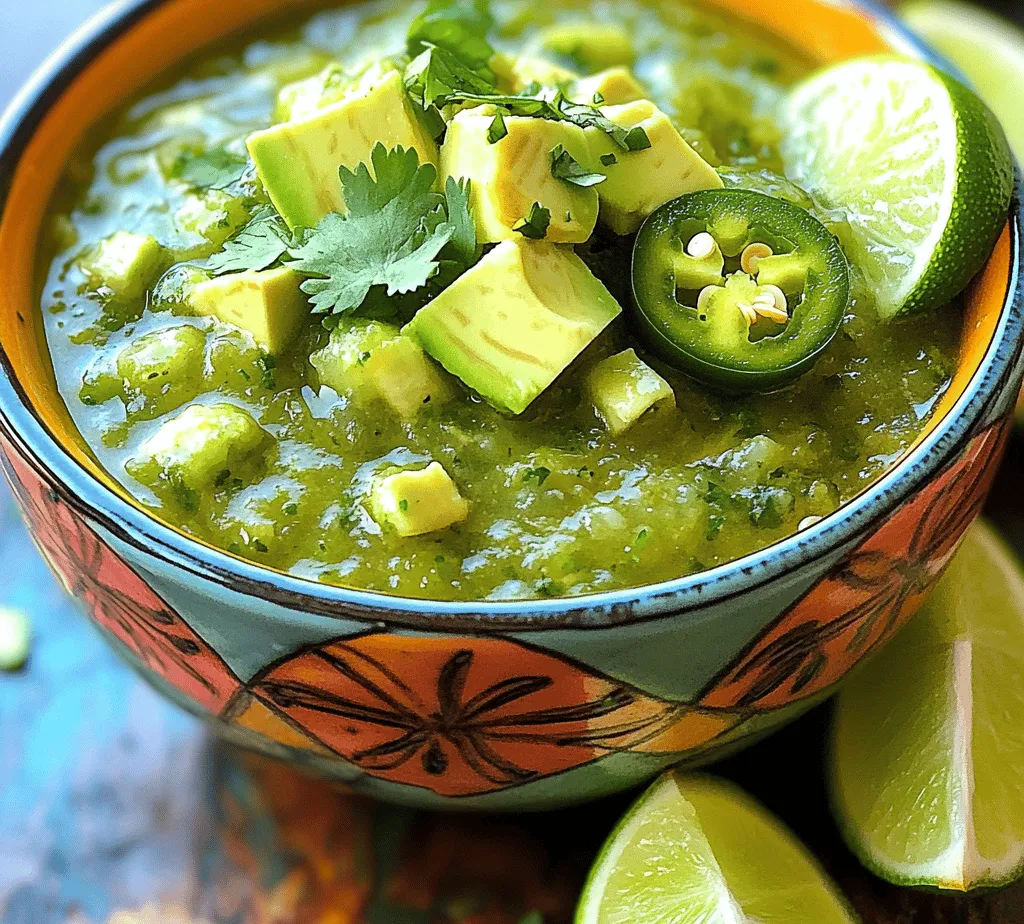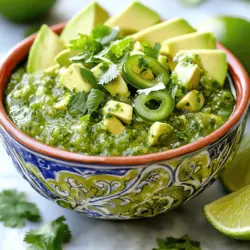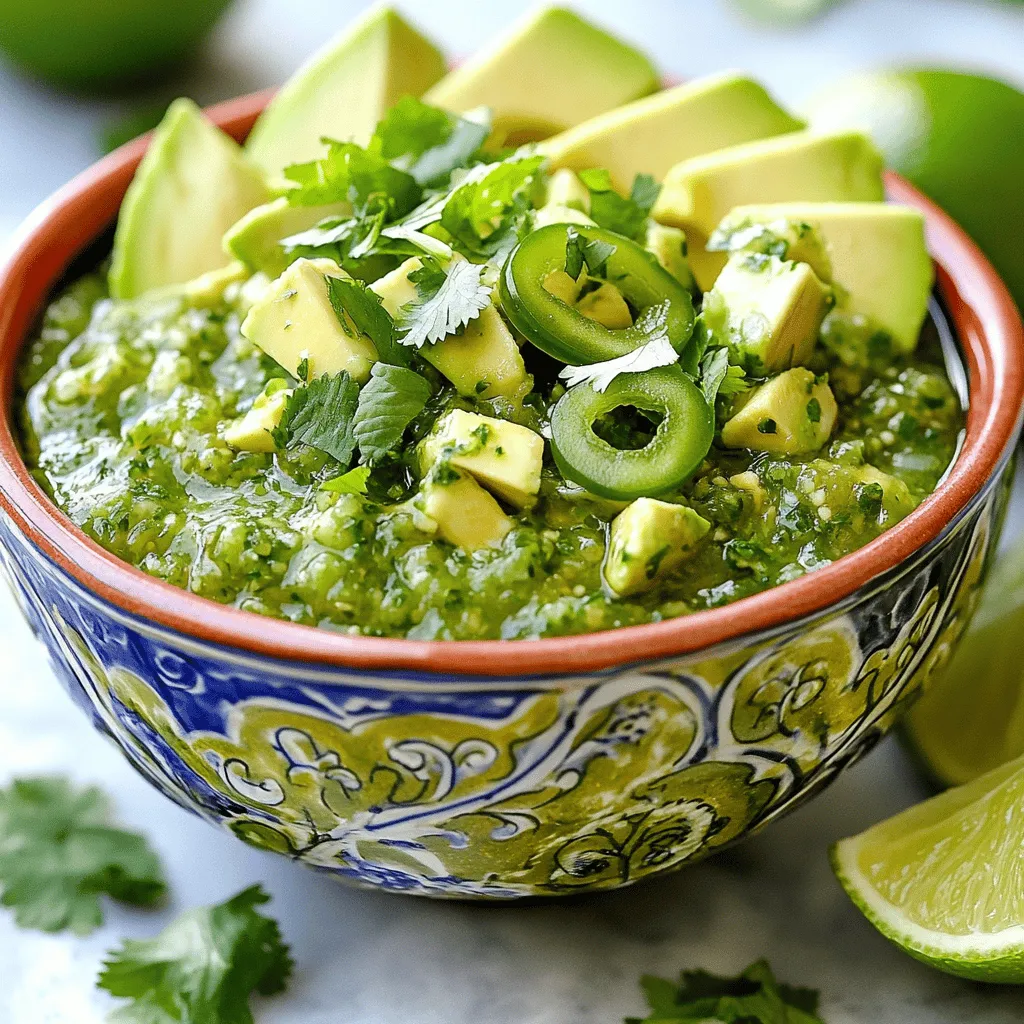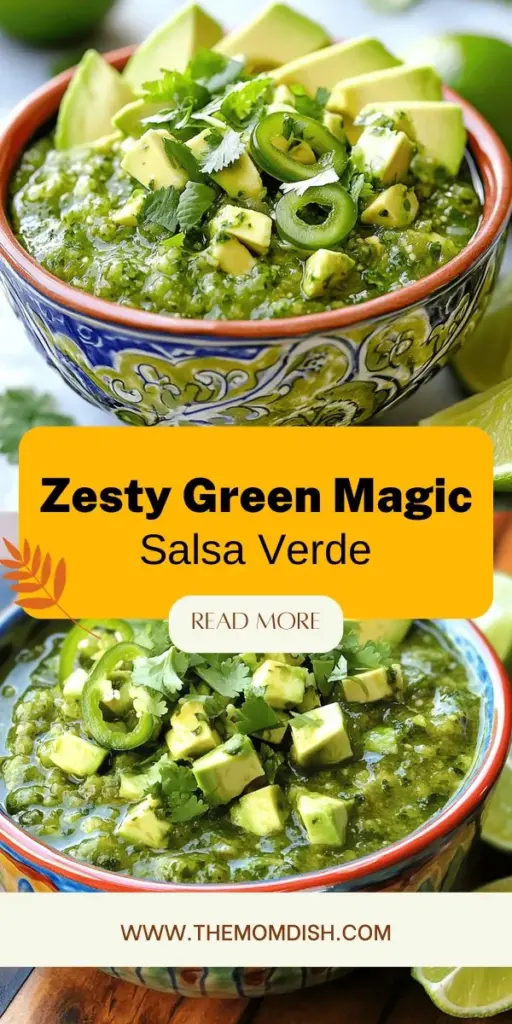Introduction
Salsa verde, a vibrant green sauce that hails from the heart of Mexican cuisine, has captured the palates of food lovers around the globe. This zesty condiment is not just a mere topping; it embodies a burst of flavor that can elevate a variety of dishes—from tacos and grilled meats to enchiladas and even as a dip for chips. Its unique blend of fresh ingredients creates a refreshing taste experience that makes it a staple in kitchens everywhere.
Introducing the Zesty Green Magic Salsa Verde, a delightful twist on the classic recipe that emphasizes a medley of fresh flavors, making it a must-try for any culinary enthusiast. This salsa verde incorporates the traditional elements while showcasing the freshness of each ingredient, resulting in a vibrant dip that is as versatile as it is delicious.
Fresh ingredients play a pivotal role in this recipe, enhancing not only the flavor profile but also the nutritional value of the dish. By using high-quality produce, you can ensure that every bite is packed with the essence of the ingredients, allowing the salsa to truly shine.
Understanding Salsa Verde
What is Salsa Verde?
Salsa verde translates to “green sauce” in Spanish and is made primarily from tomatillos, which are the foundational ingredient of this vibrant condiment. Unlike red salsa, which is typically made from ripe tomatoes, salsa verde offers a unique tartness and a fresh flavor that comes from the unripe tomatillos.
Traditionally, salsa verde includes ingredients like tomatillos, green chili peppers, cilantro, lime juice, and other seasonings. The combination of these elements creates a sauce that can be used in various culinary applications, making it a versatile addition to many meals.
Cultural Significance
In Mexican cuisine, salsa verde holds a special place. It is often served alongside traditional dishes, highlighting the freshness and complexity of the ingredients used. The vibrant green color is not only visually appealing but also represents the rich agricultural heritage of Mexico, where fresh produce is celebrated. Salsa verde is also a reflection of regional differences, with variations found across different states, each showcasing local ingredients and flavors.
Salsa Verde vs. Salsa Roja
While salsa verde is known for its bright, tangy flavor, salsa roja, or red salsa, is characterized by its smoky and rich taste, typically made with roasted ripe tomatoes and red chili peppers. The two types of salsa complement each other beautifully, providing a varied flavor experience that enhances any meal.
Salsa verde is often favored for its freshness and lightness, making it an ideal accompaniment for foods that require a zesty kick without overpowering the dish’s inherent flavors.
The Star Ingredients
Tomatillos: The Foundation of Salsa Verde
At the heart of any great salsa verde are tomatillos. These small, green fruits are enclosed in a papery husk and have a slightly tangy flavor that distinguishes them from regular green tomatoes. When selecting tomatillos, look for firm fruits that are bright green and devoid of blemishes. The freshness of tomatillos is essential, as older or overly soft fruits can lead to a less vibrant salsa.
Nutritional Benefits
Tomatillos are not only delicious but also packed with nutrients. They are rich in vitamins A and C, providing essential antioxidants that support immune health. Additionally, tomatillos contain dietary fiber, aiding in digestion and promoting gut health.
Preparing Tomatillos
Before using tomatillos in your salsa, it’s important to prepare them properly. First, remove the husks and rinse them under cold water to wash away any sticky residue. You can choose to roast, boil, or grill tomatillos, but roasting them brings out their natural sweetness and adds depth of flavor to your salsa verde.
The Role of Jalapeño in Adding Heat
Adding a jalapeño pepper to your salsa verde introduces a delightful heat that balances the freshness of the tomatillos. The level of spiciness can vary significantly among jalapeños; some may be mild while others pack a punch. When selecting jalapeños, consider the color and size—the greener and smaller the pepper, the spicier it generally is.
Variations in Heat Levels and Substitutions
If you prefer a milder salsa, you can remove the seeds and membranes from the jalapeño before adding it to your mix. Alternatively, you can substitute the jalapeño with a milder pepper, such as a poblano or bell pepper, to achieve a flavor profile that suits your palate.
Fresh Cilantro: Flavor Enhancer
Cilantro is a key ingredient in salsa verde, providing a fresh and aromatic quality that complements the other flavors. Its unique, slightly citrusy taste is integral to achieving the classic salsa verde flavor.
Nutritional Properties and Health Benefits
Beyond its flavor, cilantro is also known for its nutritional benefits. It is a rich source of vitamins K and C, and it has been linked to various health benefits, including anti-inflammatory properties and aiding in digestion.
The Importance of Fresh Lime Juice
Fresh lime juice is essential in salsa verde, as it adds acidity that balances the flavors beautifully. The tartness of lime juice cuts through the richness of any accompanying dishes, making each bite refreshing.
Red Onion and Garlic: Aromatic Components
Red onion and garlic are aromatic ingredients that contribute significant depth of flavor to salsa verde. The sharpness of red onion paired with the pungency of garlic enhances the overall taste, creating a well-rounded condiment that is both savory and refreshing.
Optional Avocado: Adding Creaminess
For those who enjoy a creamier texture, consider adding avocado to your salsa verde. This optional ingredient not only contributes a luscious mouthfeel but also infuses the salsa with healthy fats.
Nutritional Advantages and Flavor Profile
Avocado is a nutritional powerhouse, rich in heart-healthy monounsaturated fats, fiber, and essential vitamins. Its creamy texture serves to mellow the heat from the jalapeño while enhancing the overall flavor of the salsa verde.
Step-by-Step Preparation Guide
To create your Zesty Green Magic Salsa Verde, start by preparing the star ingredients. The first step is to roast the tomatillos and jalapeño, which will deepen their flavors and enhance the final result.
Roasting Tomatillos and Jalapeño
1. Preheat the Oven: Set your oven to broil or preheat to 425°F (220°C). Roasting under high heat will caramelize the sugars in the tomatillos and jalapeños, adding a delightful depth to the salsa.
2. Prepare the Ingredients: Remove the husks from the tomatillos and rinse them under cool water. Cut them in half and place them cut-side up on a baking sheet. Next, prepare the jalapeño by cutting it in half lengthwise; remove the seeds for a milder salsa, or leave them in for extra heat.
3. Roasting: Drizzle a little olive oil over the tomatillos and jalapeños, then place them in the oven. Roast for about 10-15 minutes, or until the tomatillos are soft and the skins begin to char. Keep an eye on them to prevent burning.
4. Cooling: Once roasted, remove the baking sheet from the oven and allow the tomatillos and jalapeños to cool for a few minutes. This cooling step will make them easier to handle when blending.
Following these steps will set the stage for a flavorful salsa verde that embodies the essence of fresh, vibrant ingredients. Stay tuned for the next section, where we will delve into the blending process and final touches that will elevate your Zesty Green Magic Salsa Verde to perfection.

Completing the Zesty Green Magic Salsa Verde Recipe
Roasting Process and Its Effects on Flavor
Roasting is a transformative cooking technique that enhances the natural flavors of ingredients. When applied to the components of your Zesty Green Magic Salsa Verde, roasting brings out a depth and complexity that raw ingredients simply cannot achieve. The heat caramelizes the sugars in the vegetables, adding a subtle sweetness while also creating a slight char that lends a smoky, savory quality to the salsa.
For this recipe, consider roasting tomatillos, garlic, and jalapeños. Simply place them on a baking sheet and roast in a preheated oven at 425°F (220°C) for about 15-20 minutes, or until they are softened and lightly charred. This process not only intensifies the flavors but also adds a beautiful depth to your salsa that will impress anyone lucky enough to taste it.
Blending Techniques for Achieving the Right Consistency
Achieving the perfect consistency in your salsa verde is crucial for texture and mouthfeel. Depending on personal preference, you might prefer a chunky salsa or a smoother blend. Start by adding your roasted ingredients to a blender or food processor, ensuring to include any juices that have collected on the baking sheet. This liquid will help with blending and add flavor.
For a chunkier salsa, pulse the mixture in short bursts, scraping down the sides of the container as needed. If you prefer a smoother texture, blend continuously until the desired consistency is reached. Remember, you can always add a little water or olive oil if the mixture is too thick.
Tips for Using a Blender or Food Processor Effectively
When using a blender or food processor for your salsa, there are a few key tips to keep in mind for optimal results:
1. Don’t Overfill: Avoid overfilling your blender or food processor. Leave enough space for the ingredients to move around freely, which will ensure even blending.
2. Layer Ingredients Strategically: Start with liquids at the bottom (like any lime juice or olive oil), followed by softer ingredients, and then add the harder components on top. This helps the blender or processor to work more efficiently.
3. Pulse Technique: Use the pulse function to control the consistency better, especially if you’re aiming for a chunky salsa. This technique allows you to check the texture without overblending.
4. Safety First: When blending hot ingredients, let them cool slightly before processing, or use a blender designed for hot liquids. Always remove the center cap from the lid and cover it with a towel to prevent steam build-up.
Importance of Tasting and Adjusting Seasonings
One of the most important steps in creating the perfect salsa verde is tasting and adjusting the seasonings. After blending, take a moment to taste your salsa. This is your opportunity to enhance its flavor profile.
Common adjustments include adding more salt, lime juice, or a pinch of sugar to balance out acidity. If the salsa is too spicy, consider adding a little more tomatillo or avocado to mellow the heat. Remember, flavors can be quite dynamic; what tastes good at one moment may need tweaking after the salsa has had a chance to sit.
Finding the Right Balance of Flavors
The key to a great salsa verde lies in achieving a balance of flavors: the acidity of the lime, the heat from the jalapeño, the sweetness of the roasted tomatillos, and the freshness of the cilantro. To achieve this balance, start with small amounts of each ingredient and build gradually.
For example, if you find your salsa too acidic, add a pinch of sugar or more tomatillos to counteract the tanginess. If it’s lacking freshness, consider adding more cilantro or lime juice. This iterative process will help you develop a salsa that is uniquely yours and perfectly tailored to your taste.
Incorporating Avocado: When and How to Add It for Optimal Texture
Avocado is a delightful addition to salsa verde, providing a creamy texture and a rich flavor that complements the vibrant ingredients. To incorporate avocado, simply peel, pit, and chop an avocado, then add it to the blender or food processor after you’ve pureed the other ingredients.
Blend briefly to combine, ensuring that the avocado is just mixed in and maintains some texture. Adding avocado last will prevent it from becoming too smooth and will offer a pleasant contrast to the other components of your salsa.
Flavor Development
The Science Behind Letting Salsa Sit
Once your salsa verde is prepared, it’s beneficial to let it sit for at least 30 minutes before serving. This resting period allows the flavors to meld and develop further, resulting in a more harmonious taste. The science behind this is simple: as the ingredients sit together, they release their natural oils and juices, which helps to enhance and deepen the overall flavor profile.
Explanation of How Flavors Meld and Deepen Over Time
During the resting period, the acidity from the lime juice interacts with the other ingredients, mellowing sharp flavors and allowing them to harmonize. This process can result in a salsa that tastes significantly better after a few hours, or even a day in the fridge. However, be cautious not to let it sit too long, as the freshness of the herbs can fade.
Discussion of How Serving Temperature Affects Taste
Serving temperature plays a crucial role in how flavors are perceived. Salsa verde is best served chilled or at room temperature. A cold salsa can feel refreshing and enhance the bright, zesty notes of the tomatillos and lime. When serving, consider placing your salsa verde in the refrigerator for a bit before serving or serving it directly from the fridge.
Recommendations for Serving and Enjoying
Salsa verde can be enjoyed in countless ways. It pairs beautifully with tortilla chips for a crunchy snack, but its versatility doesn’t end there. Consider the following serving suggestions:
1. Tacos: Use salsa verde as a topping for tacos filled with grilled chicken, fish, or vegetables. The salsa adds a refreshing kick that elevates the entire dish.
2. Grilled Meats: Drizzle salsa verde over grilled meats like steak, pork, or chicken to add brightness and flavor.
3. Eggs: A spoonful of salsa verde can transform a simple breakfast dish like scrambled eggs or huevos rancheros into a gourmet experience.
4. Salads: Use salsa verde as a zesty salad dressing, adding a fresh twist to your greens.
5. Soups: Stir it into soups for a burst of flavor, particularly in chicken or vegetable soups.
Presentation Tips
Ideas for Serving Salsa Verde Aesthetically
Presentation can elevate your dining experience. When serving salsa verde, consider using a colorful bowl that contrasts with the bright green of the salsa. A white or ceramic bowl can make the vibrant color pop and look visually appealing.
Bowl Selection and Garnishing with Cilantro and Lime
For a beautiful presentation, finish your salsa verde with a garnish of fresh cilantro leaves and a few lime wedges on the side. This not only enhances the visual appeal but also invites your guests to add more lime if they wish.
Suggestions for Pairing with Dishes
When planning a meal, think about how your salsa verde can complement your menu. Consider serving it with:
– Tortilla Chips: A classic pairing that never goes out of style.
– Tacos: Great for casual gatherings or taco nights.
– Grilled Meats: Perfect for barbecues or summer cookouts.
– Fish Dishes: The zesty flavors work wonderfully with grilled or baked fish.
Health Benefits of Salsa Verde
Nutritional Breakdown of Key Ingredients
Not only is salsa verde delicious, but it’s also packed with nutrients. Here’s a quick breakdown of some of the key ingredients:
– Tomatillos: Rich in vitamins C and K, as well as antioxidants.
– Cilantro: Loaded with vitamins A, C, and K, and has anti-inflammatory properties.
– Jalapeños: Contain capsaicin, which may boost metabolism and reduce inflammation.
– Avocado: High in healthy fats, fiber, and potassium, promoting heart health.
Low-Calorie, High-Nutrient Profile
Salsa verde is a low-calorie condiment that adds flavor without adding excessive calories. This makes it an excellent choice for those looking to enhance their meals without overindulging.
Benefits of Fresh Herbs and Vegetables in Diet
Incorporating fresh herbs and vegetables into your diet is essential for overall health. They provide vital nutrients, support digestion, and may even contribute to better heart health. Salsa verde, made with fresh ingredients, is an easy way to add these benefits to your meals.
How This Salsa Fits into a Healthy Eating Plan
Salsa verde can easily fit into a variety of dietary plans, whether you’re following a low-carb, vegetarian, or Mediterranean diet. Use it as a topping for lean proteins or as a dip for fresh veggies to make your meals more nutritious and enjoyable.
Conclusion
In summary, the Zesty Green Magic Salsa Verde is not just a condiment; it’s a celebration of fresh flavors and vibrant ingredients. The roasting process deepens the taste, while careful blending and flavor balancing result in a salsa that’s both delightful and versatile.
Encourage experimentation with variations or pairings—try adding different herbs, spices, or even fruits like mango for a unique twist. The joy of making and sharing homemade salsa verde is unmatched, and it’s a fantastic way to bring people together over delicious food. Embrace the process and enjoy the vibrant flavors that come from your kitchen.



